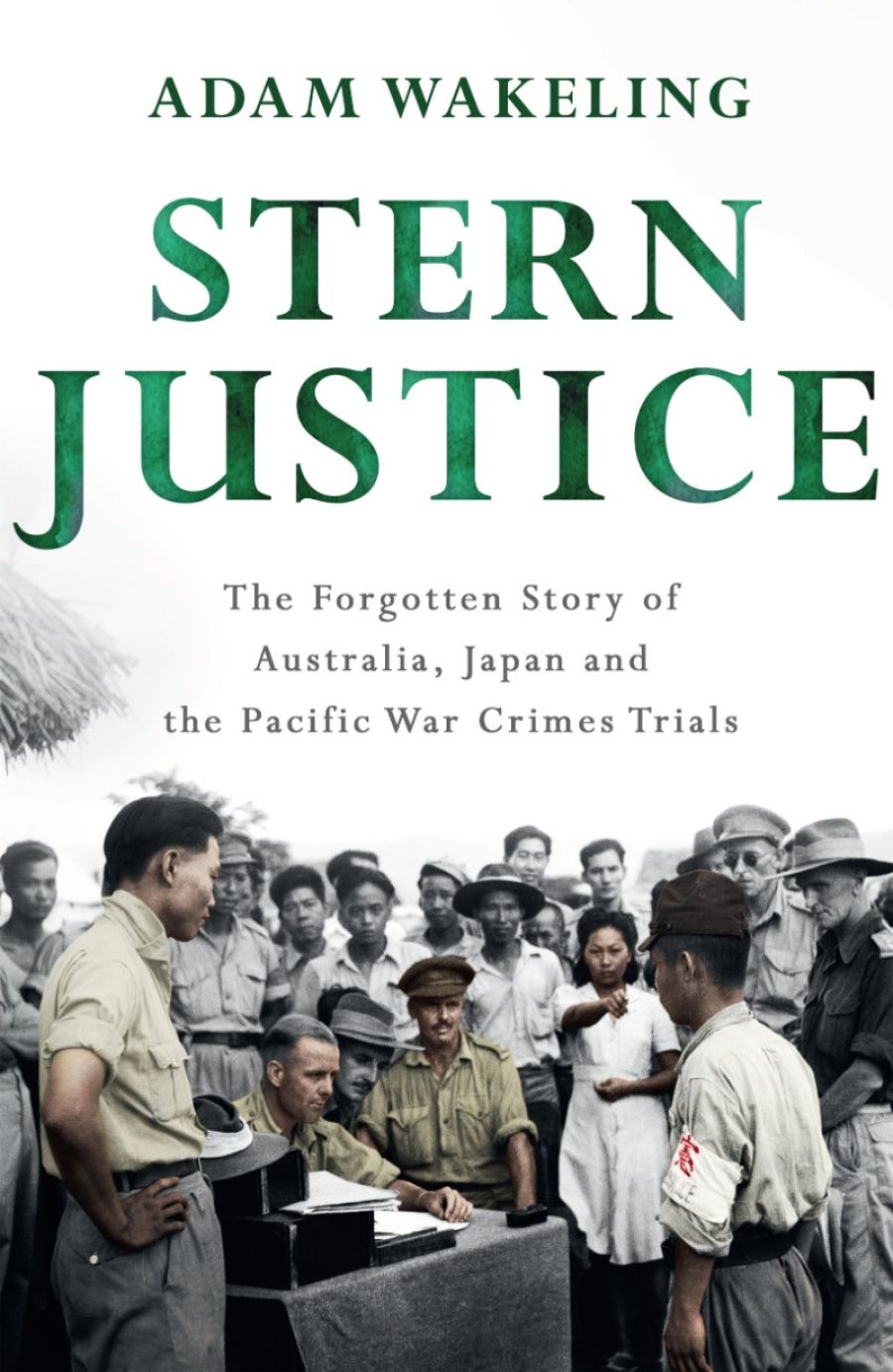
- Free Article: No
- Contents Category: History
- Custom Article Title: Michael Sexton reviews 'Stern Justice' by Adam Wakeling
- Custom Highlight Text:
Justice or vengeance? This is always the question raised by war crimes trials, although it might be noted that they are a relatively recent historical phenomenon. Some were proposed at the end of the Great War but never eventuated. The original and best known is, of course, Nuremberg at the end of World War II ...
- Book 1 Title: Stern Justice
- Book 1 Subtitle: The Forgotten Story of Australia, Japan and the Pacific War Crimes Trials
- Book 1 Biblio: Viking, $34.99 pb, 390 pp, 9780143793335
This book provides an exhaustive but highly readable account of the Tokyo trial of 1946–48, about which very little has been written in comparison with Nuremberg and the other trials, about which almost nothing has been published, conducted by the Allies at various locations in the Pacific region between late 1945 and mid-1951.
The author, himself a lawyer, explains that the charges fell into three categories: starting wars in violation of international treaties, conventional war crimes, and crimes against humanity. All the charges in the first category were heard by the International Military Tribunal for the Far East sitting in Tokyo and presided over by Sir William Webb, Chief Justice of the Queensland Supreme Court. The defendants came from the military and the bureaucracy, and the wars in question were those commenced by Japan against Manchuria in 1931, China in 1937, and the United States in 1941. The twenty-five defendants argued that the charges disclosed no crimes known to international law and that, in any event, the wars had been started in Japan’s self-defence. After proceedings lasting two and a half years, all the defendants were convicted, with seven being sentenced to death. Of the eleven judges on the tribunal, however, three dissented, with one, Justice Radhabinod Pal from India, simply rejecting the right of the Allies to conduct the trial at all and pointing to their use of the atomic bomb on Japanese civilians as conduct just as criminal.
Some of the Tokyo defendants were also convicted on charges in the second and third categories, largely arising from the Japanese capture of Nanking in 1937, when between 100,000 and 300,000 Chinese were killed and raped, and the use of prisoners of war and native labourers on the Burma railway, where more than 12,000 POWs and between 42,000 and 74,000 of the local workers died.
 Private Leo Ayers on Ambon at the time of his liberation, August/September 1945, after two and a half years of Japanese captivity after being captured in the Fall of Singapore in 1942 (AWM 116271)
Private Leo Ayers on Ambon at the time of his liberation, August/September 1945, after two and a half years of Japanese captivity after being captured in the Fall of Singapore in 1942 (AWM 116271)
Of the various trials conducted by the Allies in the Pacific region, all for second and third category offences, Australia held 294 hearings, all carried out by military courts, which resulted in 138 executions and prison sentences of varying lengths. By 1953, however, all those sentenced to prison terms had been returned to Japan and most were released by 1957. Many of these trials concerned the treatment of POWs. The samurai code of bushido, which had come to influence the Japanese military in the 1930s, supposedly dictated death before surrender, making prisoners a subject of contempt to their captors. Almost half the Australian deaths in the Pacific area – 8,000 men and women – died as POWs. The book uses as a case study the events at Sandakan in North Borneo where, out of 2,000 Australian and 750 British POWs, there were six survivors. One of the Japanese convicted over Sandakan was cynically unrepentant: ‘Whatever happens during a war, do not lose.’ As the author notes, the Japanese as a whole seemed puzzled by the trials and had little sense of national guilt over the events of the war.
Towards the end of the book, the author takes up the question of the morality of these and other war crimes trials. It is certainly open to point to mass killings of civilians by the Allies at Nagasaki and Hiroshima. But it would be hard to deny that there was a difference overall between the way the war was conducted by the Allies as opposed to the Germans and Japanese, who, it can be said, also initiated the conflict.
Some of those who objected to the trial process did so not because they considered that the defendants did not deserve punishment but because it was done under a cloak of legality. Chief Justice Harlan Stone of the United States Supreme Court wrote privately about his fellow Justice Robert Jackson, who had taken leave from the court to lead the prosecution team at Nuremberg: ‘I don’t mind what he does to the Nazis, but I hate to see the pretence that he is running a court and proceeding according to common law. This is a little too sanctimonious a fraud to meet my old-fashioned ideas.’
Does this mean that summary execution of those considered to have committed war crimes is a better alternative? Overall, Wakeling believes that the Tokyo trial and the other hearings carried out in the Pacific region served the useful purpose of identifying the conduct of those prosecuted for the community in countries like Australia and had an element of fairness that would have been lacking in summary executions. This is the conventional view of war crimes trials, but their morality and utility will continue to be the subject of ongoing debate.
(A tick means you already do)



Comments powered by CComment